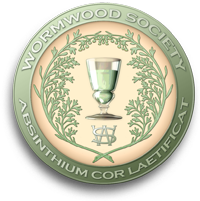
Absinthe: The Rise, Fall and Resurrection of the Green Fairy
The “Secondary” Effect
So what is the secondary absinthe effect that one hears so much about?
Some people—but not all—have observed a very subtle and short-lived “buzz” when drinking authentic absinthe. It is usually described as a sort of mental clarity or a “clear-headed” drunk: whereas most liquor produces a slower, thicker mental state, absinthe seems to contain a balanced stimulant effect. When one would normally be slurring and weaving and nodding off after too much Bourbon, one is likely to be still quite convivial, bright and alert after a few absinthes. This is not to say one doesn’t get every bit as intoxicated from absinthe. Over-indulgence quickly replaces this clarity with the more familiar deleterious effects of any alcohol.
It appears that the relaxing and disinhibiting effects of alcohol are complimented by the stimulation and lightness thought to result from the particular combination of herbs. Modern research suggests that it is the combination of herbal ingredients, more particularly the fenchone from the fennel and the anethol from the anise, which works in synergy with the other ingredients to produce this effect. The author has experienced a “secondary effect” identical to that of absinthe, from drinking a liquor made from fennel alone. It should be repeated that not everyone experiences “secondaries” and that some believe them to be nothing more than the placebo effect.
Absinthe Reborn
Absinthe wasn’t banned everywhere. Although its decline into obscurity no doubt engendered the supposition that the ban was universal, absinthe remained legal in the UK, Spain, and Eastern Europe. Of course that’s probably because it was never very popular in these places and was not perceived as being a problem. Still, absinthe production dwindled and by the mid 1900’s had all but disappeared except for the clear “la bleue” bootleg or “clandestine” absinthe of the Val de Travers region of Switzerland, which has flourishes up to the present.
After a period of 40 years of relative obscurity, during which the reputation of absinthe took on a shape more appropriate to an urban legend, the Green Fairy was ready to re-emerge from her cocoon, twisted into a most unlikely and—to anyone who knew her—unrecognizable form. In Czechia in 1990, just after the Velvet Revolution and the return of privately owned enterprise, a small distillery began producing what it called “absinth.”
According to their official history, Hill’s Liguere was established in 1920 by Albin Hill. He starting out as a wine wholesaler and soon after began producing his own liquor and liqueurs. In 1947, his son Radomil opened his own branch of the business and it was then that they began producing “absinth,” 160 proof Alpsky Rum and Zubrówka (bison grass vodka, “good for the sex drive!”). The next year the communist regime took over and seized the distillery, putting the Hills out of work. After the revolution in 1990, Radomil having successfully negotiated for the return of his property, he began producing Hill’s Absinth.
It should be noted that although there exists much absinthe-related art and antiques from all over France and Switzerland from before the bans a hundred years ago—glasses, spoons, advertising posters, menus, distiller’s catalogs and invoices, books and distillation manuals, antique absinthe bottles of many brands, paintings depicting absinthe and absinthe drinkers—there is so far nothing which suggests that Hill’s absinth existed prior to 1990.
The liquor is a very pale turquoise blue and bears no resemblance to absinthe. It contains little or no anise and does not louche when water is added. Tests have suggested that it possibly contains no wormwood and its peculiar minty flavor has been compared to mouthwash. It is almost certainly an “oil mix,” meaning that essential oils are simply mixed with a neutral alcohol base, artificially colored and then bottled rather being distilled from natural herbs, as an authentic absinthe would be. By all appearances Hill, knowing that precious few people in his market knew anything about what absinthe should be like, and very likely not knowing himself, simply concocted an odd-tasting liquor and dubbed it “Absinth.” Subsequent Czech imitators came up with similar inventions and worse: noting that bitterness was among the words used to describe pre-ban absinth, they conjectured that it should be terribly, terribly bitter. Consequently, many Czech absinths are.
Nonetheless, Hill’s and absinth made its way into the bars and rock clubs of Czechia, especially Prague, where it was discovered by the metal, darkwave and punk set—the bohemians of our time; and where better than Bohemia itself? In some cases, confusion of the essentially unrelated 19th century French use of the term “bohemian” has been opportunistically used to validate the lineage of Czech absinth.
Part of the romance and interest of authentic absinthe lay in its ritualistic preparation—the sugar cube and the special spoon; the dripping water; watching the louche develop and smelling the herbal fragrances bloom. Unfortunately, most Czech absinths don’t louche. A new element was necessary to make the paraphernalia relevant.
No doubt borrowing the preparation of the Café Brûlot, a traditional coffee drink where a brandy or cognac-soaked sugar lump is ignited in a spoon before adding it to the coffee, people began lighting absinth-soaked sugar on fire before dumping it in their drink along with the water. This makes for an initially interesting and dramatic display, as any flambé will, but the burnt sugar adhering to the spoon, the indissoluble globs at the bottom of the glass, and the introduced charred taste of carbonized sugar will leave a true absintheur cold. Of course this ritual also calls to mind the preparation of heroin by cooking it in a spoon; another unfortunate connection with illicit and dangerous drugs.
With very few exceptions, Czech absinths are considered to be inferior, and in most cases outright fraudulent imitations of authentic absinthe.
